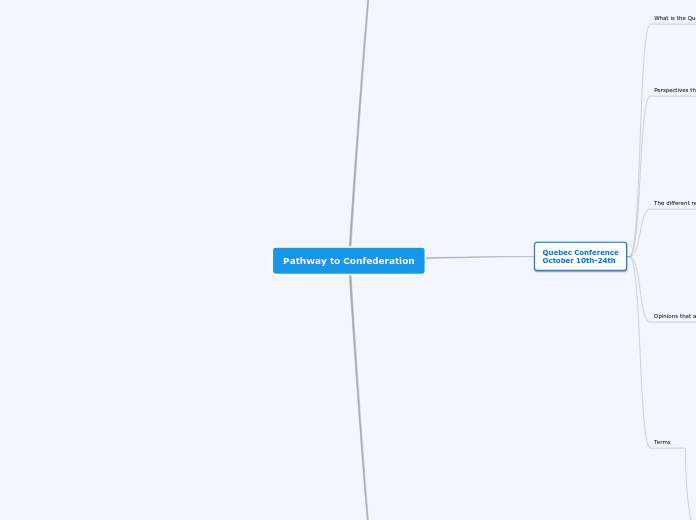Pathway to Confederation
Charlotte Town Conference
September 1st- 9th 1864
Charles Tupper and Johnathan Mccully
Supported uniting all the provinces he was reluctant to abandon the Maritime Union altogether.
Samuel Leonard Tilley
Since his youth, he had always dreamed of a great British North American nation.
Perspectives that were not represented
No delegates spoke for the sizable population Irish community.
Andrew Archibald MacDonald was the only catholic in the meeting.
There were no francophone delegates
Indigenous and Black Canadians were excluded from the public.
The Agenda
In 1862 the Canadian Province refused to pay
part of the costs for the Inter colonial Railway.
This started discussions between the maritime
provinces about merging into a single unit and
having a stronger political government.
Representatives
Nova Scotia
~Charles Tupper
~ Attorney General, William Alexander Henry
~Robert Barry Dickey
~ Liberal Leader, Adams George Archibald
New Brunswick
~Reform Premier, Samuel Leonard Tilley
~ Attorney General John Mercer Johnson
~ Minister, William Henry Steeves
~Veteran Conservative, Edward Barron Chandler
~John Hamilton Gray
Prince Edward Island
~Conservative Premier John Hamilton Gray
~ William Henry Pope
~Edward Palmer
~ Liberals, George Coles and Andrew A. Macdonald
~ Three Delegates, Palmer, Coles and Macdonald
Quebec Conference
October 10th-24th
What is the Quebec Conference
The Quebec conference is Where Many of the same delegates and who met in Charlottetown And was the Fathers of confederation.
Perspectives that were not represented
The First Nations were not mentioned in the process of the confederation. Their needs and wants were not voiced in the confederation.
None of the 11 groups of first nations in Canada East did not get a chance to voice their opinions on the conference.
Nor did black people get a chance to express their opinion.
Women were also not invited to speak at the confederation as they were restricted to be politicians at the time.
The different representatives
People who represented Canada East in the Quebec conference were George-Étienne Cartier, Thomas D'Arcy McGee and Étienne-Paschal Taché.
George-Étienne Cartier is one of the many politicians of both Canada East and West.
John Hamilton Gray and Samuel Leonard Tilley from New Brunswick. Tilley was a member of the liberal party and Gray was a member of the Conservative party. Adams George Archibald and Charles Tupper from Nova Scotia. Tupper represented the conservative party and Archibald was a liberal-conservative.
Opinions that are Represented
The opinions of people of Canada East, Canada West, and people from maritime provinces were the only known opinions to be expressed during the Quebec conference.
Canada West wanted to join for the benefits of a better military, better trading system, and more taxes that would then be collected and used for the population’s benefit. British Columbia also was willing to join so they can pay off their debt(from the gold rush downfall).
Terms
After the Quebec conference the British North Americans act of 1867, The Quebec conference the delegates agreed that a new federal government will help fund and and help finish the construction of the Inter colonial Railway in Quebec city to the maritime.
A total of 72 resolutions were agreed upon at this very conference. 50 of which John A. MacDonald had crafted. Mainly the resolutions were about the distributions of power(the system of federal, provincial and municipal governments). The provincial government was now in control of schooling, municipalities, and language. Meanwhile the federal government controlled currency, international trade, and criminal laws. However some power was shared such as agriculture, immigration and tax.
London Conference
December 4,1866 - February 1867
The Agenda
To complete negotiations for confederation and get the approval from the British Government. They wanted to establish ground rules and name for the new confederation of canada.
They also wanted to review the 72 resolutions that were made in the Quebec conference.
Fun fact
The representatives wished to name our country the “Kingdom of Canada”, but the British feared that such a title would anger the United States, so they settled on the title as “Dominion of Canada” and not “Kingdom”.
Opinions
Sir John A Macdonald wanted to unify the country, The British Prime Minister John Russell, was in favour of confederation the successor of John Russell, Lord Carnava also approved of confederation.
The Roman Catholic bishops were demanding guarantees protecting the separate Catholic schools in this conference.
However, this idea was opposed by the Nova Scotia and New Brunswick representatives. What ended up happening as a compromise was that Catholic schools would be guaranteed in Ontario and Quebec, but not in Nova Scotia or New Brunswick.
Alexander Galt also demanded protection for the rights of the English minority living in Quebec, and Samuel Tilley and Charles Tupper added more federal subsidies in the Maritime regions.
people that were not represented
A separate anti-Confederation group was happening in London led by Nova Scotia Joseph Howe.
Irish perspectives were not represented
African American perspectives were not represented and In the British North American Act they were not mentioned.
First nations perspectives were not represented. Although act passed at this conference contained things about first nations reserves and land.
Terms
Nova Scotia and New Brunswick made some changes to the 72 resolutions (the Quebec conference)
New Brunswick got assurances that a railway would be built
The provincial government subsidies increased.
People that attended
16 representatives from Nova Scotia and New Brunswick attended, including John A. MacDonald (conservative), George Étienne Cartier, Alexander Galt and George Brown (liberal).
